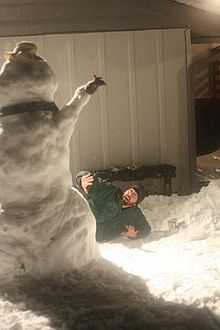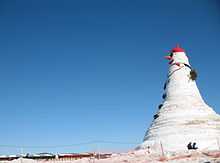Snowman

A snowman is an anthropomorphic snow sculpture. In some cases, participants in winter festivals will build large numbers of snowmen. Because a snowman is situation-specific, it is a good example of popular installation art.
In North America, typical snowmen consist of three large snowballs with some additional accoutrements for facial and other features. Common accessories include branches for arms and a rudimentary smiley face; a carrot can stand in for a nose. Human clothing, such as a hat or scarf, may even be included. Low-cost and availability are the common issues, since snowmen are usually in a cold and/or wet environment, and abandoned to the elements once completed. Melting is a common end-of-life scenario for most snowmen.
Construction

Snow becomes suitable for packing when it approaches its melting point and becomes moist and compact. This allows for the construction of a large snowball by simply rolling it, until it grows to the desired size. If the snow ball reaches the bottom of the grass it may tear up some grass, gravel, dirt etc. Making a snowman of powdered snow is difficult since it will not stick to itself, and if the temperature of packing snow drops, it will form an unusable denser form of powdered snow called crust. Thus the best time to build a snowman is usually in the next warm afternoon directly following a snowfall with a sufficient amount of snow. In Europe and North America, snowmen are built with three spheres depicting the head, torso, and lower body.
The usual practice is to then dress the snowman, usually with rocks, coal, sticks, and vegetables. Carrots or cherries are often used for the nose, as are sticks for arms and stones for eyes (traditionally lumps of coal or, if coal is not in wide use in the area, charcoal). Some like to dress their snowmen in clothing (scarves, jackets, hats). Others prefer not to risk leaving supplies out doors where they could easily be stolen or become stuck under melting ice. There are variations to these standard forms; for instance, the subject of the popular song "Frosty the Snowman" includes a corncob pipe, button nose, coal eyes and an old silk hat (usually depicted as a top hat). These other types range from snow columns to elaborate snow sculptures (similar to ice sculptures).
Snowmen are usually built with two spheres in East Asia. In Japan, they are called yuki daruma (雪だるま yuki daruma) after the round shape of the Daruma doll.
-
A Boise, Idaho "snowfamily" with various whimsical accessories.
-

A "carrot-nose" snowman
History

Documentation of the first snowman is unclear. However, Bob Eckstein, author of The History of the Snowman documented snowmen from medieval times, by researching artistic depictions in European museums, art galleries, and libraries. The earliest documentation he found was a marginal illustration from a work titled Book of Hours from 1380, found in Koninklijke Bibliotheek, in The Hague.[1]
In Media
Snowmen are a popular theme for Christmas and winter decorations and also in children's media. A famous snowman character is Frosty, the titular snowman in the popular children's song "Frosty the Snowman" (later adapted into film and television specials), who was magically brought to life by the old silk hat used on his head. In addition to numerous related music and other media for Frosty, snow-men also feature as:
- Arktos in the German animated series Tabaluga.
- Bouli, a French animated series about a snowman's adventures in a magical place.
- in the game Mother there is a town called Snowman.
- Der Schneemann, a 1943 animated short film created in Germany.
- Jack Frost (1998 film), a movie with Michael Keaton in which he wakes up as a snowman after a car accident.
- Jack Frost (1996 film), a horror movie in which a serial killer is transformed into a snowman.
- Rave Master, a Japanese manga in which Plue, the hero's companion, resembles a small snowman.
- The Snowman, British picture book (1978) by Raymond Briggs and animation (1982) directed by Dianne Jackson about a boy who builds a snowman that comes alive and takes him to the North Pole.
- Calvin and Hobbes, an American cartoon by Bill Watterson, contains many instances of Calvin building snowmen, many of which are deformed or otherwise abnormal, often used to poke fun at the art world.[2]
- The song “Nothing’s Gonna Change My Clothes” from the eponymous They Might Be Giants album posits the existence of a snowman with protective rubber skin.
- Steven Millhauser, in one of his collections of short stories, called In the Penny Arcade wrote a short story called Snowmen in which children make snowmen which are more and more elaborate.
- Snow Bros, an arcade game released in 1990 featuring two snowball-throwing snowmen as the protagonists.
- Hans Christian Andersen wrote a winter fairy story, The Snowman.
- "The Snowmen", the 2012 Christmas special from the BBC science fiction TV series Doctor Who, features snowman-like monsters
- The 2013 film Frozen features a living snowman named Olaf voiced by Josh Gad who longs to see summer.
World's largest snowman

The record for the world's largest snowman was set in 2008 in Bethel, Maine. The snow-woman stood 122 feet 1 inch (37.21 m) in height, and was named in honor of Olympia Snowe, the senior Republican U.S. Senator representing Maine.[3]
The previous record was also a snowman built in Bethel, Maine, in February 1999. The snowman was named "Angus, King of the Mountain" in honor of the then current governor of Maine, Angus King. It was 113 feet 7 inches (34.62 m) tall and weighed over 9,000,000 pounds (4,080,000 kg).[4]
Variations
Children in snowsuits between two Hattifattener snowmen in Finland.
In addition to snowmen, other things can be produced with similar materials. Typical variations on the snowman concept include using raw materials other than snow, or using similar materials but a new meme. See snow sculpture.
In areas after a prolonged hailstorm, which can occur at any time of year, the accumulated hail can mix together with rain to form a substance similar to snow. It is possible to create snowman-like sculptures from this substance.
-
Snowrabbit
-

Desert "snowmen", Tohono Chul Park, Tucson, Arizona, USA
A snowman variation which has gathered significant notice in the press is the so-called Snowzilla.
Snowman-inspired
Snowmen can also be a theme for toys, costumes, and decorations.
-

A stuffed toy snowman
-

Snowman-inspired bronze sculpture
-
Children follow person in Snowman costume
Unicode
A snowman symbol is included in the Unicode character set with code point U+2603. (☃) Later editions of Unicode, not yet widely supported, also include alternate snowmen at U+26C4 (⛄) and U+26C7 (⛇)
References
- ↑ Eckstein, Bob (2008-12-02). "My Search for The First Snowman". The History of the Snowman. Open Salon. Retrieved 2010-01-11.
- ↑ Calvin and Hobbes Snow Art Gallery
- ↑ 2008 World’s Tallest SnowWoman
- ↑ "Angus, King of the Mountain — World's Largest Snowman". Sunday River On-Line. February 19, 1999. Archived from the original on 2007-10-12.
Further reading
- Bob Eckstein, The History of the Snowman: From the Ice Age to the Flea Market (2007)
- Scottie Davis, "Snow Day, A Photographic Journal of the Best Snowmen" (2004)
- Sandy Kinnee, Lost Origins of the Snowman: Bloodless Sacrifice" 2012 http://www.blurb.com/books/3109857
| Look up snowman in Wiktionary, the free dictionary. |
| Wikimedia Commons has media related to Snowman. |




